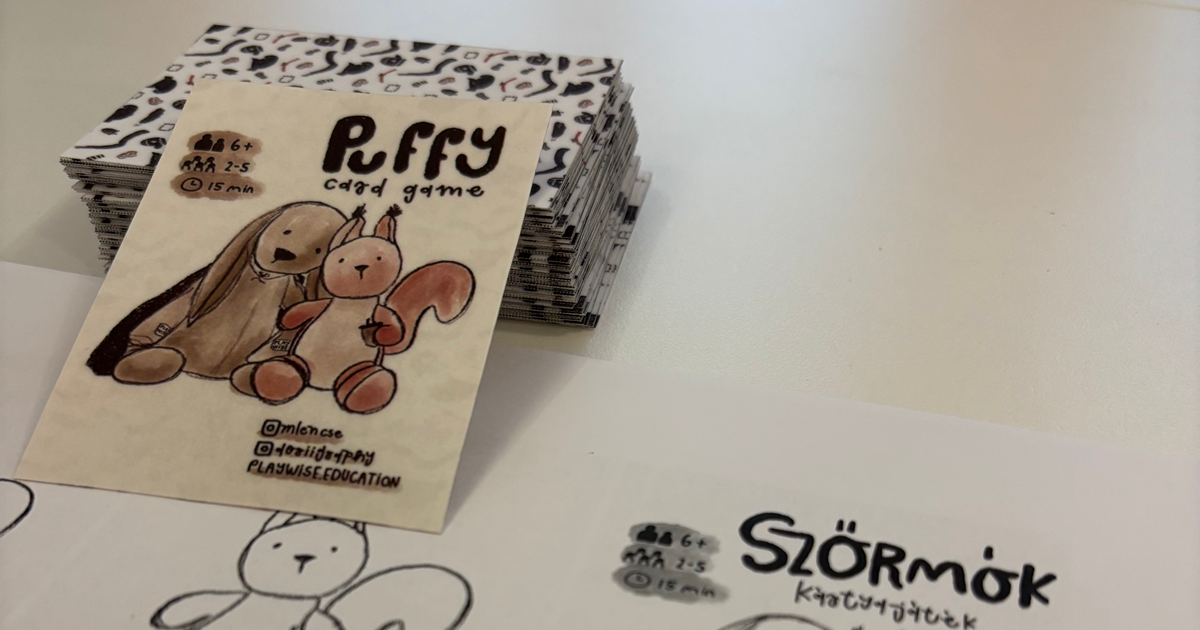I’ve never opened an exhibition before, but now I can check that off my list as well. At the request of Nestingplay, I had the opportunity to speak at an exhibition showcasing items created during thematic camps for Ukrainian refugee children. The Mayor of Budapest was present, and UNICEF was represented, so it was quite an honor. But what made it truly special was the chance to speak about the importance and benefits of play in front of an exhibition where the objects were created through play. I didn’t deliver my prepared speech word for word, but this is roughly what I said:
"My name is Máté Lencse, and I am a teacher and board game designer. Since 2012, I have been running the after-school program of the Igazgyöngy Foundation, and since 2013, I have been using board games to achieve educational goals.
Now, I’d like to talk a bit about games, or more specifically, about playing itself, which might add something to your experience of this exhibition.
In March 2022, I was really focused on finding a place where I could go and play board games with Ukrainian refugee children. (I eventually ended up at Suhanj!, where I was able to volunteer a few times, but that’s not the main point here—it just felt relevant to mention.)
Over the past 10-12 years, this has somehow become my instinctive reaction: I grab some board games and bring them into whatever situation I’m facing. I find it easier to communicate about anything, with anyone, through board games than in any other way. And when I communicate through board games, I usually can’t resist playing something together because nothing is more powerful than personal experience. If there were six to eight volunteers here willing to come up and play in front of everyone, it would greatly help me convey what I want to say."
(We played a round of Happy Salmon here, and then we discussed the educational benefits hidden within the game. I often use this game for this purpose because it’s a 90-second party game—a bit of madness—and if we can find useful elements in something as short and chaotic as this (and there are plenty!), it’s easy to imagine how much a more complex game can offer.)
"In the book Didactics—which aims to describe the entirety of education—very little is said about play. In fact, play is associated with trivial learning, which frustrated me for a long time. Then I realized that it’s actually hard to say anything more accurate about play, even though I believe the truth I’ve discovered about it wasn’t included in that statement. The greatest virtue of play is, indeed, its light-heartedness. It’s built on this, and we—as adults and professionals—can build on it too, provided we can accept light-heartedness as a positive characteristic. Let’s give it a try!
Play is “as if.” Play is when we can pretend in ways we otherwise couldn’t. Play is when we can try anything, even things we would never dare to in real life. Seriously, we wouldn’t. My mentor and friend, József Jesztl, once said about board games that things don’t happen to us; it’s the poor pawn fumbling around the board. And that makes it so much easier. We explore all kinds of uncharted paths. We can repeatedly do something we enjoy. We can relive seemingly one-time experiences. All of this is action, doing, happening. And from all this action, doing, and happening, comes a wealth of experience and learning. So, let’s create opportunities for play whenever we can.
Play is a child’s natural state; they play even in situations where we adults would find it unimaginable. When I first started working with disadvantaged children, what surprised me most was how little their situation affected their mood. How easily they could be drawn into play. How easy it was to keep them engaged in play—if you find the right game for them—even throughout an entire day at camp. Because they need it. Over the past decade or more, I’ve also seen how much they’ve developed through play, particularly through board games in our case. Not to mention that play, especially board games, has shaped my own approach to teaching: I’ve realized that I’m a patient, indirect teacher, not just when I create play situations but in all pedagogical settings. Only in this framework, by letting children work through things on their own, do I see a chance to move forward.
I said that children play even in situations where it seems unimaginable to us. But that doesn’t mean we have no responsibility here. Let’s not take play away from children—whether through war, poverty, or overburdening. Our job is to understand that play is good. Play is good because it’s good for the child, and it’s good for us—adults, parents, professionals—because the child develops through it. As a side note: sometimes, we could even let go of this obsessive desire to constantly develop them.
As we walk around this exhibition, let’s also see the play behind it. Because a lot happened to bring all this around us into existence. And all of that was play. But what play!"
(photo by Mile Máté/Józsefváros Újság)




